Corrosion Performance of Fe-Based Amorphous Coatings via Laser Cladding Assisted with Ultrasonic in a Simulated Marine Environment
Abstract
:1. Introduction
2. Experimental Procedure
2.1. Coating Preparation
2.2. Microstructure Examinations
2.3. Corrosion Tests
3. Results and Discussion
3.1. Microstructural Examination Results
3.2. Corrosion Test Results
4. Conclusions
- (1)
- Fe-based amorphous coatings (U0 and U1000) are composites composed of amorphous phases and crystal phases, including (FenCr23−n) (BmC6−m) and bcc-Fe (Cr, Co). Ultrasonic promotes crystallization of the coating (U1000) but has little effect on the amorphous content of the coating surface.
- (2)
- There are gradient structures at the junction of the coatings (U0 and U1000) and substrates, composed of a planar crystal layer, columnar crystal layer, and equiaxed crystal layer. Ultrasonic increases the average thickness of the gradient structure, thereby reducing surface cracks on the coating (U1000).
- (3)
- The Fe-based amorphous coating (U1000) prepared using laser cladding with ultrasonic shows better corrosion resistance than the Fe-based amorphous coating (U0) fabricated without ultrasonic, but much lower than the bulk amorphous material with the same chemical composition.
- (4)
- The crystallization products of the coatings (U0 and U1000), including (FenCr23−n) (BmC6−m), cause Cr element segregation in the coating (U0 and U1000), significantly hindering passivation film forming. Electrochemical reactions between amorphous and crystal phases accelerate the passive film’s dissolution.
- (5)
- After immersion corrosion of the coating (U1000), cracks become wide. This presents inverted wedge shapes with narrow tops and wide bottoms, which are related to the potential gradient caused by an increase of the amorphous phase from the bottom to the surface of the coating. Crack corrosion hollows out the coating and substrate binding zone, accelerating coating failure.
Author Contributions
Funding
Data Availability Statement
Acknowledgments
Conflicts of Interest
References
- Mohamed, A.E. Offshore Structures, 2nd ed.; Gulf Professional Publishing: Houston, TX, USA, 2012; pp. 383–443. [Google Scholar]
- Subrata, K.C. Handbook of Offshore Engineering; Elsevier Science: Amsterdam, The Netherlands, 2005; pp. 1127–1143. [Google Scholar]
- Campbell, S.A.; Campbell, N.; Walsh, F.C. Developments in Marine Corrosion; Woodhead Publishing: Sawston, UK, 1998. [Google Scholar]
- Li, H.X.; Lu, Z.C.; Wang, S.L.; Wu, Y.; Lu, Z.P. Fe-based bulk metallic glasses: Glass formation, fabrication, properties and applications. Prog. Mater. Sci. 2019, 103, 235–318. [Google Scholar] [CrossRef]
- Souza, C.A.C.; Ribeiro, D.V.; Kiminami, C.S. Corrosion resistance of Fe-Cr-based amorphous alloys: An overview. J. Non-Cryst. Solids 2016, 442, 56–66. [Google Scholar] [CrossRef]
- Wang, H.Z.; Cheng, Y.H.; Yang, J.Y.; Wang, Q.Q. Influence of laser remelting on organization, mechanical properties and corrosion resistance of Fe-based amorphous composite coating. Surf. Coat. Technol. 2021, 414, 127081. [Google Scholar] [CrossRef]
- Hashimoto, K. 2002 WR Whitney Award Lecture: In Pursuit of New Corrosion-Resistant Alloys. Corrosion 2002, 58, 715–722. [Google Scholar] [CrossRef]
- Lou, H.B.; Wang, X.D.; Xu, F.; Ding, S.Q.; Cao, Q.P.; Hono, K.; Jiang, J.Z. 73 mm-diameter bulk metallic glass rod by copper mould casting. Appl. Phys. Lett. 2011, 99, 051910. [Google Scholar] [CrossRef]
- Zhang, C.; Guo, R.Q.; Yang, Y.; Wu, Y.; Liu, L. Influence of the size of spraying powders on the microstructure and corrosion resistance of Fe-based amorphous coating. Electrochim. Acta 2011, 56, 6380–6388. [Google Scholar] [CrossRef]
- Zhou, Z.; Wang, L.; Wang, F.C.; Zhang, H.F.; Liu, Y.B.; Xu, S.H. Formation and corrosion behavior of Fe-based amorphous metallic coatings by HVOF thermal spraying. Surf. Coat. Technol. 2009, 204, 563–570. [Google Scholar] [CrossRef]
- Koga, G.Y.; Wolf, W.; Schulz, R.; Savoie, S.; Bolfarini, C.; Kiminami, C.S.; Botta, W.J. Corrosion and wear properties of FeCrMnCoSi HVOF coatings. Surf. Coat. Technol. 2019, 357, 993–1003. [Google Scholar] [CrossRef]
- Marzo, F.F.; Pierna, A.R.; Vega, M.M. Effect of irreversible structural relaxation on the electrochemical behavior of Fe78−xSi13B9Cr(x=3,4,7) amorphous alloys. J. Non-Cryst. Solids 2003, 329, 108–114. [Google Scholar] [CrossRef]
- Berger, J.E.; Jorge, A.; Koga, G.Y.; Roche, V.; Kiminami, C.S.; Bolfarini, C.; Botta, W.J. Influence of chromium concentration and partial crystallization on the corrosion resistance of FeCrNiB amorphous alloys. Mater. Charact. 2021, 179, 111369. [Google Scholar] [CrossRef]
- Gan, Z.; Zhang, C.; Zhang, Z.R.; Chen, Z.J.; Liu, L. Crystallization-dependent transition of corrosion resistance of an Fe-based bulk metallic glass under hydrostatic pressures. Corros. Sci. 2021, 179, 109098. [Google Scholar] [CrossRef]
- Lin, T.J.; Sheu, H.H.; Lee, C.Y.; Lee, H.B. The study of mechanical properties and corrosion behavior of the Fe-based amorphous alloy coatings using high velocity oxygen fuel spraying. J. Alloys Compd. 2021, 867, 159132. [Google Scholar] [CrossRef]
- Wang, S.L.; Zhang, Z.Y.; Gong, Y.B.; Nie, G.M. Microstructures and corrosion resistance of Fe-based amorphous/nanocrystalline coating fabricated by laser cladding. J. Alloys Compd. 2017, 728, 1116–1123. [Google Scholar] [CrossRef]
- Gargarella, P.; Almeida, A.; Vilar, R.; Afonso, C.R.M.; Peripolli, S.; Rios, C.T.; Bolfarini, C.; Botta, W.J.; Kiminami, C.S. Formation of Fe-based glassy matrix composite coatings by laser processing. Surf. Coat. Technol. 2014, 240, 336–343. [Google Scholar] [CrossRef]
- Lu, Y.Z.; Huang, G.K.; Wang, Y.Z.; Li, H.G.; Qin, Z.X.; Lu, X. Crack-free Fe-based amorphous coating synthesized by laser cladding. Mater. Lett. 2018, 210, 46–50. [Google Scholar] [CrossRef]
- Cui, Y.; Shen, J.Q.; Geng, K.P.; Hu, S.S. Fabrication of FeCoCrNiMnAl0.5-FeCoCrNiMnAl gradient HEA coating by laser cladding technique. Surf. Coat. Technol. 2021, 412, 127077. [Google Scholar] [CrossRef]
- Guo, S.F.; Liu, L.; Li, N.; Li, Y. Fe-based bulk metallic glass matrix composite with large plasticity. Scr. Mater. 2010, 62, 329–332. [Google Scholar] [CrossRef]
- Zhao, Y.L.; Zhang, W.W.; Meng, F.S.; Wang, Z.; Zhang, D.T.; Yang, C. Microstructure and Mechanical Properties of as-Cast Al-5.0Cu-0.6Mn-0.6Fe Alloy Produced by Ultrasonic Vibration and Applied Pressure. Rare Met. Mater. Eng. 2018, 47, 457–462. [Google Scholar]
- Zhu, S.H.; Wang, N.Q.; Li, S.; Huang, G.; Ge, S.; Du, P.H.; Zhang, L.; Sun, Y.F.; Guan, S.K. Study on the materials flow, microstructure and mechanical properties of ultrasonic vibration-assisted friction stir weld of 1500 MPa martensitic steel. Mater. Charact. 2023, 206, 113409. [Google Scholar] [CrossRef]
- Mohsan, A.U.H.; Zhang, M.N.; Wang, D.F.; Zhao, S.; Wang, Y.S.; Chen, C.Y.; Zhang, J.H. State-of-the-art review on the Ultrasonic Vibration Assisted Laser Cladding (UVALC). J. Manuf. Process. 2023, 107, 422–446. [Google Scholar] [CrossRef]
- Wang, H.Z.; Cheng, Y.H.; Yang, J.Y.; Liang, X.B. Microstructure and properties of Fe based amorphous coatings deposited by laser cladding under different preheating temperatures. J. Non-Cryst. Solids 2023, 602, 122081. [Google Scholar] [CrossRef]
- Zhu, Y.Y.; Li, Z.G.; Li, R.F.; Li, M.; Feng, K.; Wu, Y.X.; Wada, T.; Kato, H. High power diode laser cladding of Fe–Co–B–Si–C–Nb amorphous coating: Layered microstructure and properties. Surf. Coat. Technol. 2013, 235, 699–705. [Google Scholar] [CrossRef]
- Xiao, M.Y.; Jiang, F.C.; Guo, C.H.; Song, H.L.; Dong, T. Investigation on microstructure and mechanical properties of Fe-based amorphous coatings prepared via laser cladding assisted with ultrasonic vibration. Opt. Laser. Technol. 2023, 262, 109294. [Google Scholar] [CrossRef]
- Zeng, X.R.; Hu, Q.; Fu, M.W.; Xie, S.H. Investigation of the free volume change of Fe41Co7Cr15Mo14C15B6Y2 bulk metallic glass using the cyclic thermal dilatation test. J. Non-Cryst. Solids 2012, 358, 2682–2686. [Google Scholar] [CrossRef]
- Nespolo, M. Unravelling the diffraction pattern of a twin. I. Fundamentals. Z. Krist-Cryst. Mater. 2016, 231, 553–560. [Google Scholar] [CrossRef]
- Milanti, A.; Matikainen, V.; Koivuluoto, H.; Bolelli, G.; Lusvarghi, L.; Vuoristo, P. Effect of spraying parameters on the microstructural and corrosion properties of HVAF-sprayed Fe–Cr–Ni–B–C coatings. Surf. Coat. Technol. 2015, 277, 81–90. [Google Scholar] [CrossRef]
- Lin, C.H.; Duh, J.G. Corrosion behavior of (Ti–Al–Cr–Si–V)xNy coatings on mild steels derived from RF magnetron sputtering. Surf. Coat. Technol. 2008, 203, 558–561. [Google Scholar] [CrossRef]
- Chou, W.J.; Yu, G.P.; Huang, J.H. Corrosion behavior of TiN-coated 304 stainless steel. Corros. Sci. 2001, 43, 2023–2035. [Google Scholar] [CrossRef]
- Wang, L.; Chao, Y.S. Corrosion behavior of Fe41Co7Cr15Mo14C15B6Y2 bulk metallic glass in NaCl solution. Mater. Lett. 2012, 69, 76–78. [Google Scholar] [CrossRef]
- Suryanarayana, C.; Inoue, A. Bulk Metallic Glasses, 1st ed.; CRC Press: Boca Ratton, FL, USA, 2011. [Google Scholar]
- Yang, Y.; Zhang, C.; Peng, Y.; Yu, Y.; Liu, L. Effects of crystallization on the corrosion resistance of Fe-based amorphous coatings. Corros. Sci. 2012, 59, 10–19. [Google Scholar] [CrossRef]
- Duarte, M.J.; Kostka, A.; Jimenez, J.A.; Choi, P.; Klemm, J.; Crespo, D.; Raabe, D.; Renner, F.U. Crystallization, phase evolution and corrosion of Fe-based metallic glasses: An atomic-scale structural and chemical characterization study. Acta Mater. 2014, 71, 20–30. [Google Scholar] [CrossRef]
- Li, H.X.; Yi, S. Corrosion behaviors of bulk metallic glasses Fe66.7C7.0Si3.3B5.5P8.7Cr2.3Al2.0Mo4.5 having different crystal volume fractions. Mater. Chem. Phys. 2008, 112, 305–309. [Google Scholar] [CrossRef]
- Tan, M.W.; Akiyama, E.; Habazaki, H.; Kawashima, A.; Asami, K.; Hashimoto, K. The role of chromium and molybdenum in passivation of amorphous Fe-Cr-Mo-P-C alloys in deaerated 1 M HCl. Corros. Sci. 1996, 38, 2137–2151. [Google Scholar] [CrossRef]
- Pang, S.; Zhang, T.; Asami, K.; Inoue, A. Formation of bulk glassy Fe75–x–yCrxMoyC15B10 alloys and their corrosion behavior. J. Mater. Res. 2011, 17, 701–704. [Google Scholar] [CrossRef]
- Wang, Y.; Jiang, S.L.; Zheng, Y.G.; Ke, W.; Sun, W.H.; Wang, J.Q. Effect of molybdenum, manganese and tungsten contents on the corrosion behavior and hardness of iron-based metallic glasses. Mater. Corros. 2014, 65, 733–741. [Google Scholar] [CrossRef]
- Hirschorn, B.; Orazem, M.E.; Tribollet, B.; Vivier, V.; Frateur, I.; Musiani, M. Determination of effective capacitance and film thickness from constant-phase-element parameters. Electrochim. Acta 2010, 55, 6218–6227. [Google Scholar] [CrossRef]
- Lukács, Z. The numerical evaluation of the distortion of EIS data due to the distribution of parameters. Electroanal. Chem. 1997, 432, 79–83. [Google Scholar] [CrossRef]
- Lukács, Z. Evaluation of model and dispersion parameters and their effects on the formation of constant-phase elements in equivalent circuits. Electroanal Chem. 1999, 464, 68–75. [Google Scholar] [CrossRef]
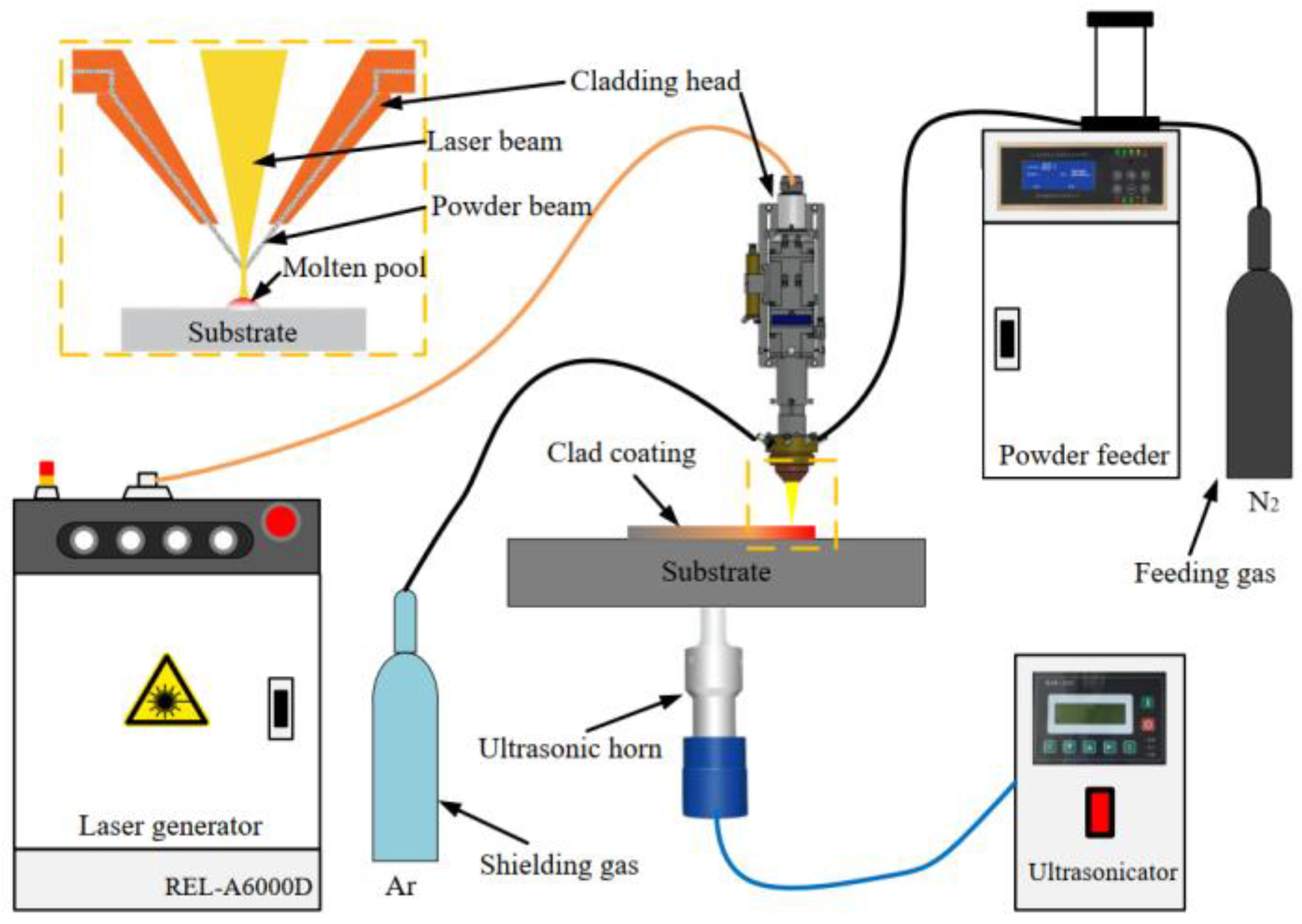

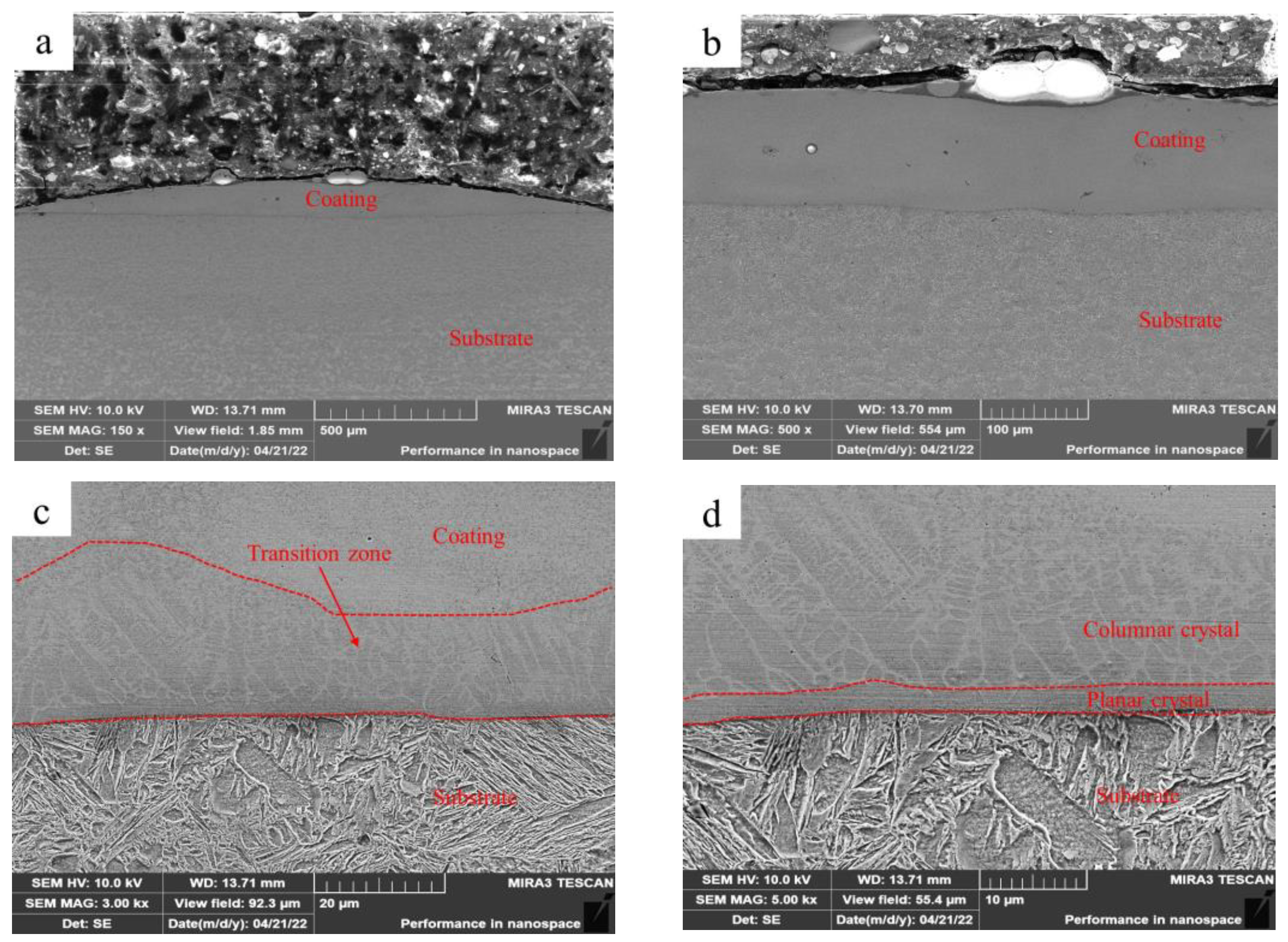
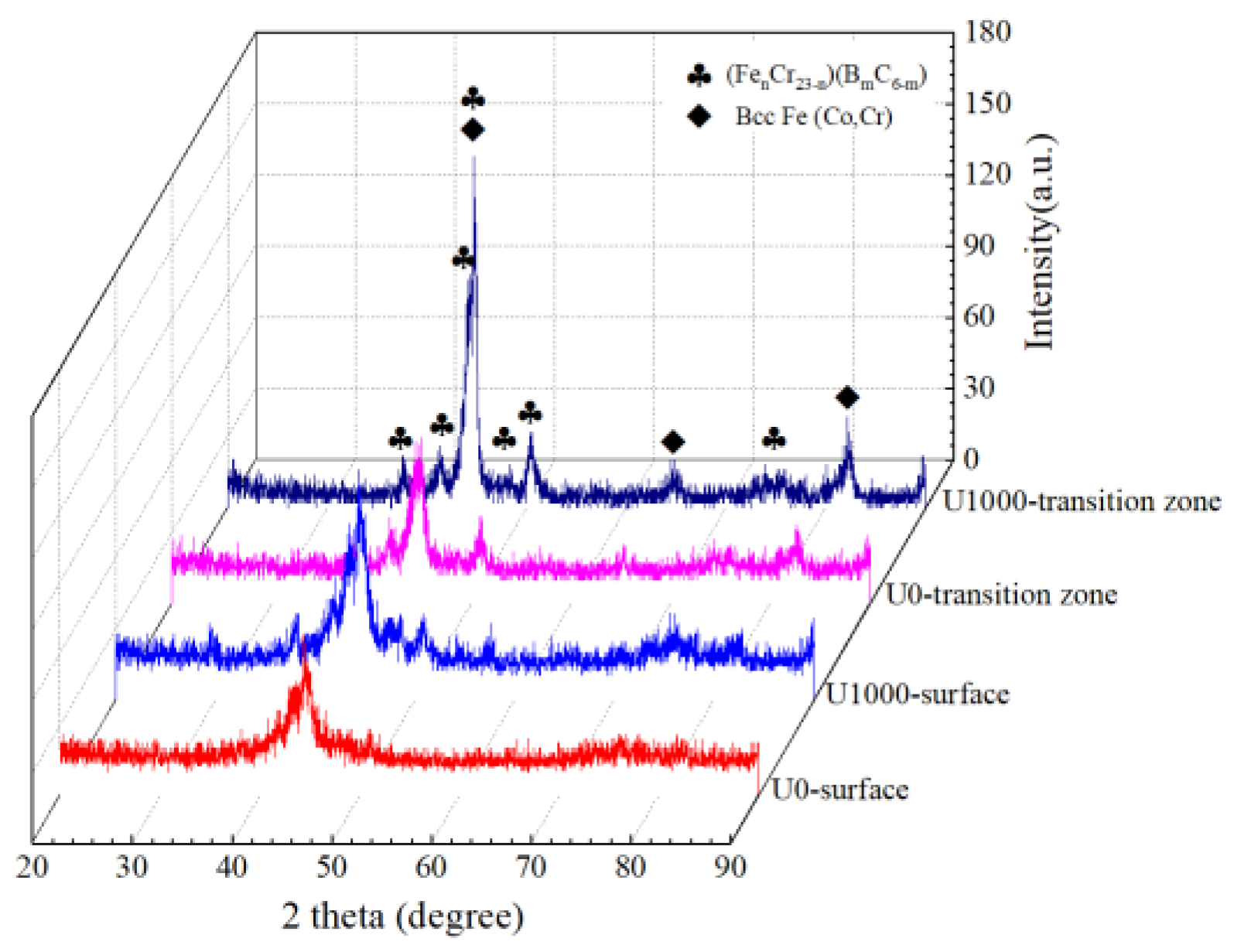
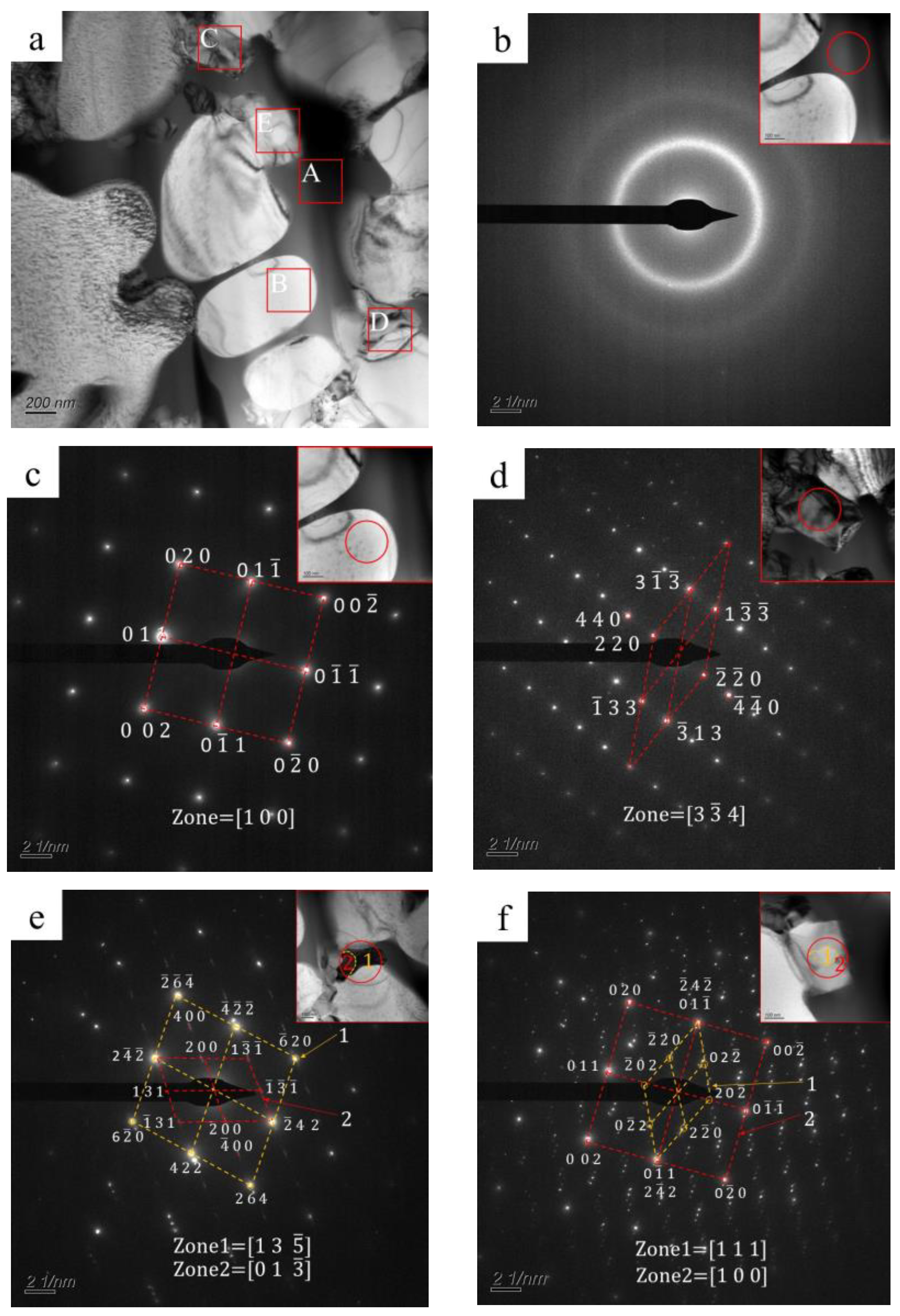
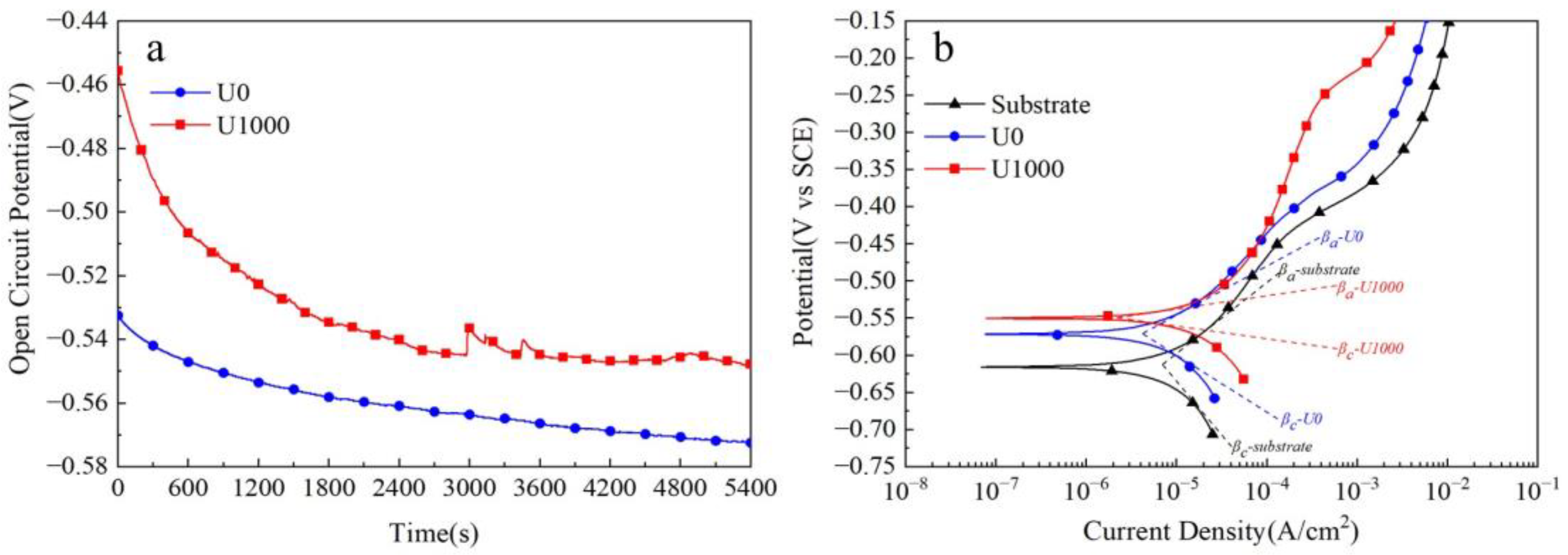

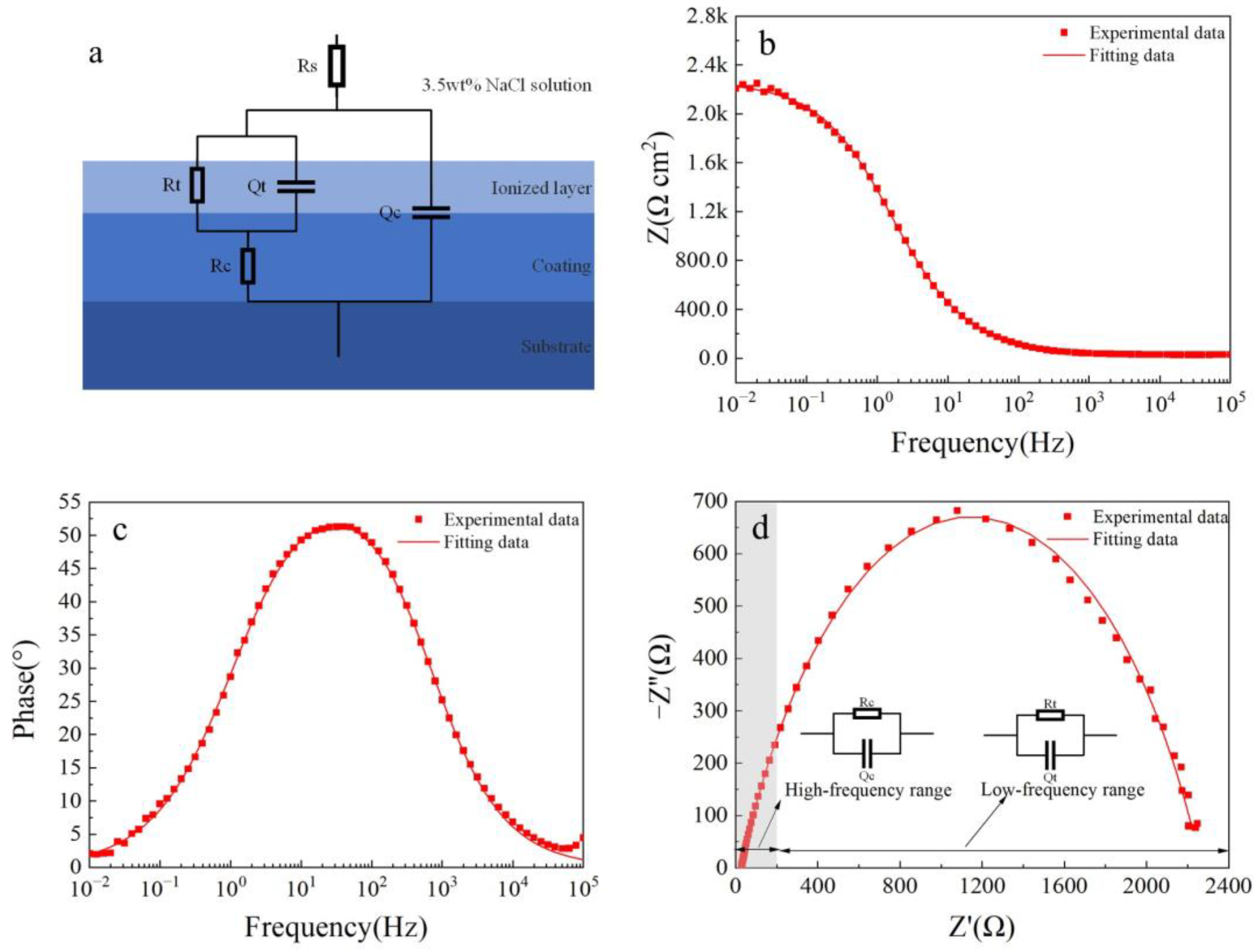

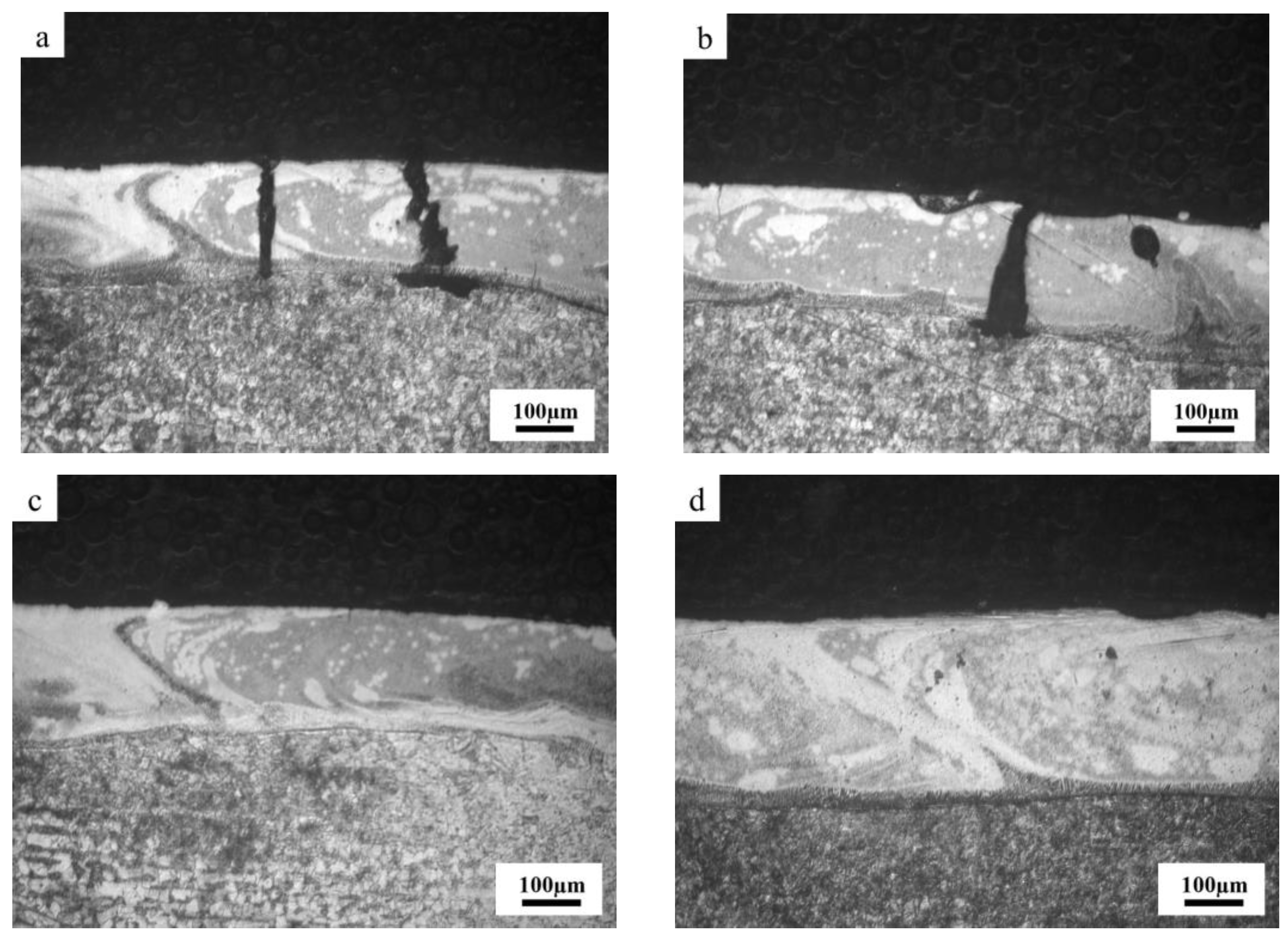
| Sample No. | Laser Power | Spot Diameter | Scanning Speed | Powder Feeding Rate | Ultrasonic Frequency | Vibration Amplitude | Ultrasonic Power |
|---|---|---|---|---|---|---|---|
| U0 | 2500 W | 3 mm | 3 m/min | 32 g/min | 20 kHz | 25 μm | 0 W |
| U1000 | 2500 W | 3 mm | 3 m/min | 32 g/min | 20 kHz | 25 μm | 1000 W |
| Sample | Self-Corrosion Potential (V) | Self-Corrosion Current (A/cm2) | Tafel Anodic Slope (V/dec) | Tafel Cathodic Slope (V/dec) | Polarization Resistance (Ω) | Corrosion Rate (mm/year) |
|---|---|---|---|---|---|---|
| U1000 | −0.55 | 1.12 × 10−5 | 0.22 | 0.18 | 3846 | 0.13 |
| U0 | −0.57 | 2.79 × 10−5 | 0.25 | 0.24 | 1905 | 0.33 |
| Substrate | −0.61 | 8.34 × 10−5 | 0.33 | 0.29 | 804 | 0.92 |
| Fitted Parameters | Unit | Value |
|---|---|---|
| Solution resistance/Rs | Ω·cm2 | 28.7 |
| Coating resistance/Rc | Ω·cm2 | 587 |
| Coating capacitance/Qc | μF/s(1 − α) cm2, α = 0.74 | 79.5 |
| Charge transfer resistance/Rt | Ω·cm2 | 1650 |
| Double-layer capacitance/Qt | μF/s(1 − α) cm2, α = 0.58 | 74 |
| Fitted Parameters | Unit | Value |
|---|---|---|
| Solution resistance/Rs | Ω·cm2 | 30.8 |
| Coating resistance/Rc | Ω·cm2 | 87.1 |
| Coating capacitance/Qc | μF/s(1 − α) cm2, α = 0.86 | 34.1 |
| Charge transfer resistance/Rt | Ω·cm2 | 632 |
| Double-layer capacitance/Qt | μF/s(1 − α) cm2, α = 0.61 | 132 |
| Crack resistance/Rt | Ω·cm2 | 673 |
| Crack capacitance/Qt | μF/s(1 − α) cm2, α = 0.63 | 1390 |
Disclaimer/Publisher’s Note: The statements, opinions and data contained in all publications are solely those of the individual author(s) and contributor(s) and not of MDPI and/or the editor(s). MDPI and/or the editor(s) disclaim responsibility for any injury to people or property resulting from any ideas, methods, instructions or products referred to in the content. |
© 2023 by the authors. Licensee MDPI, Basel, Switzerland. This article is an open access article distributed under the terms and conditions of the Creative Commons Attribution (CC BY) license (https://creativecommons.org/licenses/by/4.0/).
Share and Cite
Han, H.; Xiao, M.; Wang, Q. Corrosion Performance of Fe-Based Amorphous Coatings via Laser Cladding Assisted with Ultrasonic in a Simulated Marine Environment. Metals 2023, 13, 1938. https://doi.org/10.3390/met13121938
Han H, Xiao M, Wang Q. Corrosion Performance of Fe-Based Amorphous Coatings via Laser Cladding Assisted with Ultrasonic in a Simulated Marine Environment. Metals. 2023; 13(12):1938. https://doi.org/10.3390/met13121938
Chicago/Turabian StyleHan, Huawei, Mingying Xiao, and Qichen Wang. 2023. "Corrosion Performance of Fe-Based Amorphous Coatings via Laser Cladding Assisted with Ultrasonic in a Simulated Marine Environment" Metals 13, no. 12: 1938. https://doi.org/10.3390/met13121938





